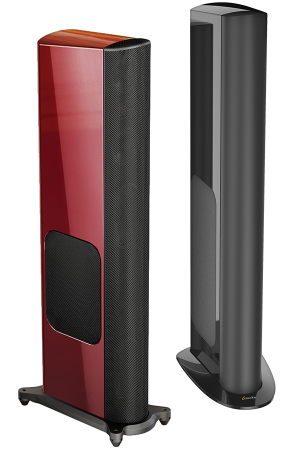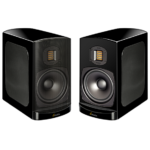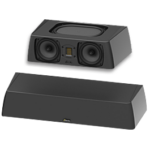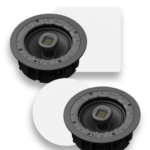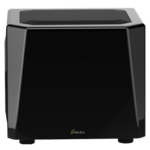Glossary
Loudspeaker Terminology
The effective bass output of the speaker measured in an anechoic chamber (see below).
An accepted practice is to quote the lowest frequency achieved by the speaker at a point -6db down from the 0db average measured output level.
Bear in mind that the lowest note reachable by a grand piano is a low “A,” which has a frequency of 27.5Hz. This note has a fundamental wavelength of 12.374m. So, to hear that note, without any boundary re-enforcement or room coloration, the piano (or speaker) would have to be 12.37m away from any boundaries.
An acoustically dead and inert room essentially free from room-dependent bass modes and reflections that would artificially skew a loudspeaker’s acoustic measurements. The best examples of these are anechoic rooms with enough volume to allow for an unrestricted 30Hz sinewave to coalesce.
All physical structures typically have at least two resonant points (one low frequency and one high frequency). In practice, there can be many. These can affect the linear pistonic movement of the loudspeakers’ drive-units, which is especially problematic at lower frequencies. Sandwich-dampened and heavily braced materials with different resonant properties are means of combating this distortion. Another is to symmetrically stagger bass radiators into opposing sides of the cabinet. This assures that the greatest internal forces are relieved or canceled by these passive-radiating bass drivers.
The summation of all harmonic components (aberrations) of the voltage and or current audio signal, compared against its fundamental (pure, undistorted) audio signal.
Refers to a loudspeaker’s sound level in decibels (dB), typically determined by measuring the speaker under anechoic conditions on-axis (that is, with a microphone placed directly at the loudspeaker) at 1 meter. A middle frequency of the speaker’s chosen frequency bandwidth is selected, and the connected power amplifier is calibrated to output precisely 1 watt. In this instance, decibels measure volume, with a more efficient loudspeaker playing louder than a less efficient one at identical input power.
This distortion occurs as any cone or planar element is required to move inward and outward to produce a given frequency and sound pressure level. As the cone or planar element moves farther inward and outward when producing complex tones, the resulting Doppler effect — a sudden change in pitch, such as that of a passing siren — increases. Thus, as the square area of the radiating material (particularly for low frequencies) increases, measurable distortion decreases.
The center channel is the most important speaker in a Home Theater system. It produces all of the voices that come from actors on the screen. Choosing a center channel speaker with great high-fidelity gives you the added benefit of something called “dialog intelligibility”, or the ability for the listener to clearly hear what is being said in the movie dialog. As with rears and surrounds, typical placement options in most home theaters require that the center channel speaker be horizontal rather than vertical. This means the speaker must have been specifically designed to be used in a horizontal configuration, just putting a vertical speaker sideways will not yield the necessary fidelity and desired dialog intelligibility for multiple listeners in the Home Theater.
Refers to the amount of opposition to current flow in an electrical circuit. For a loudspeaker, this is the measure signal, sometimes referred to as AC impedance, and it is measured in Ohms. This is not DC (direct current) impedance, and such measurements will not be useful or appropriate. The loudspeaker’s nominal impedance is important as different power amplifiers’ circuits are optimized for a given nominal impedance. (A tube amplifier’s performance, for instance, can vary depending on the selected output tap). For other power amplifiers and receivers, this number can help determine the maximum output a power amplifier’s circuit can produce (into a given loudspeaker impedance).
This occurs when two or more audio signals are used in a non-linear (imperfect, thus, distortion-producing) system. The spectrum at the output of the non-linear device will consist of the original (pure) audio signals, but it will also contain the sum and difference of the input signals along with their harmonics.
GoldenEar Drive-Unit Technology
Refers to the structural frame or basket of the driver, as used in GoldenEar’s mid/bass drivers. Instead of being made from inferior punched and bent metal, the frame is cast, affording greater rigidity and integrity.
Uses drivers mounted at precisely calculated angles to create palpable, well-focused images across an expansive soundstage.
GoldenEar’s version of an Air Motion Transformer (AMT) high-frequency driver. Essentially, a folded ribbon of circuit material that uses an amplifier signal to oscillate and squeeze the air around it. Unlike the pistonic, pulsing motion of a dome tweeter, an AMT’s movement is more like that of an accordion’s bellows.
Indicates the extended travel, or inward and outward movement, achievable by a driver while pumping the air in front of it.
Located at the center of some GoldenEar midrange drivers, this device eliminates the distortion from non-linear pistonic movement from a typical dust cap at midrange and high audio frequencies.
GoldenEar’s version of an Auxiliary Bass Radiator (ABR). Unlike typical bass units, these are not electrically connected to any associated bass driver within the speaker but are instead coupled to the bass driver(s) by the air pressure inside the cabinet. When implemented properly, ABRs achieve a balanced combination of desirable attributes common to other bass-loading methods: mechanical efficiency, extended low-frequency response, improved low-frequency impact, and minimal distortion.

